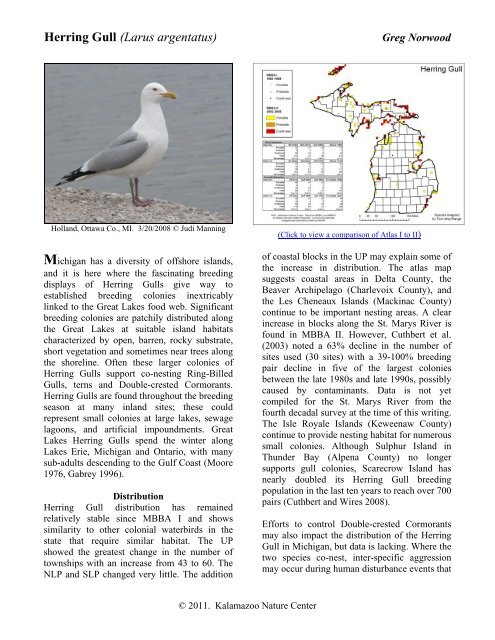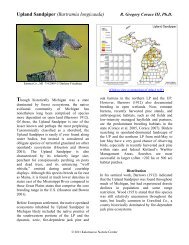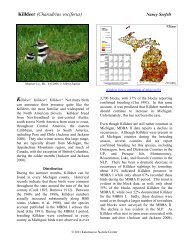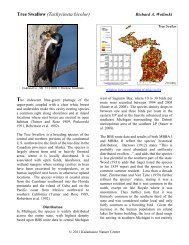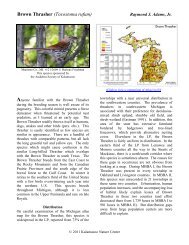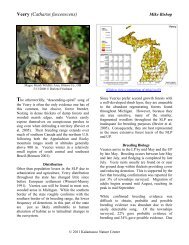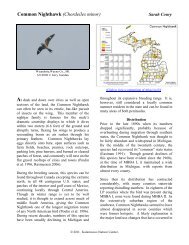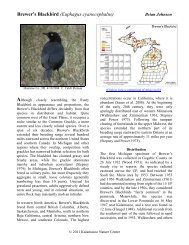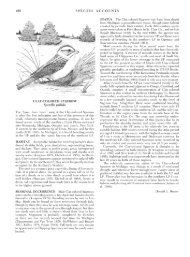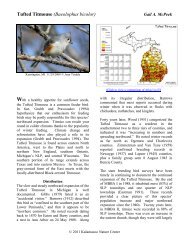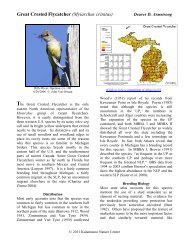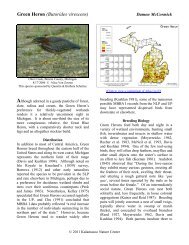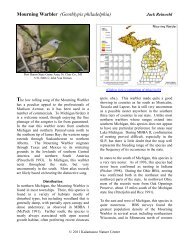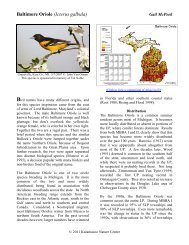Herring Gull - Michigan Breeding Bird Atlas Website
Herring Gull - Michigan Breeding Bird Atlas Website
Herring Gull - Michigan Breeding Bird Atlas Website
You also want an ePaper? Increase the reach of your titles
YUMPU automatically turns print PDFs into web optimized ePapers that Google loves.
<strong>Herring</strong> <strong>Gull</strong> (Larus argentatus)Greg NorwoodHolland, Ottawa Co., MI. 3/20/2008 © Judi Manning<strong>Michigan</strong> has a diversity of offshore islands,and it is here where the fascinating breedingdisplays of <strong>Herring</strong> <strong>Gull</strong>s give way toestablished breeding colonies inextricablylinked to the Great Lakes food web. Significantbreeding colonies are patchily distributed alongthe Great Lakes at suitable island habitatscharacterized by open, barren, rocky substrate,short vegetation and sometimes near trees alongthe shoreline. Often these larger colonies of<strong>Herring</strong> <strong>Gull</strong>s support co-nesting Ring-Billed<strong>Gull</strong>s, terns and Double-crested Cormorants.<strong>Herring</strong> <strong>Gull</strong>s are found throughout the breedingseason at many inland sites; these couldrepresent small colonies at large lakes, sewagelagoons, and artificial impoundments. GreatLakes <strong>Herring</strong> <strong>Gull</strong>s spend the winter alongLakes Erie, <strong>Michigan</strong> and Ontario, with manysub-adults descending to the Gulf Coast (Moore1976, Gabrey 1996).Distribution<strong>Herring</strong> <strong>Gull</strong> distribution has remainedrelatively stable since MBBA I and showssimilarity to other colonial waterbirds in thestate that require similar habitat. The UPshowed the greatest change in the number oftownships with an increase from 43 to 60. TheNLP and SLP changed very little. The addition(Click to view a comparison of <strong>Atlas</strong> I to II)of coastal blocks in the UP may explain some ofthe increase in distribution. The atlas mapsuggests coastal areas in Delta County, theBeaver Archipelago (Charlevoix County), andthe Les Cheneaux Islands (Mackinac County)continue to be important nesting areas. A clearincrease in blocks along the St. Marys River isfound in MBBA II. However, Cuthbert et al.(2003) noted a 63% decline in the number ofsites used (30 sites) with a 39-100% breedingpair decline in five of the largest coloniesbetween the late 1980s and late 1990s, possiblycaused by contaminants. Data is not yetcompiled for the St. Marys River from thefourth decadal survey at the time of this writing.The Isle Royale Islands (Keweenaw County)continue to provide nesting habitat for numeroussmall colonies. Although Sulphur Island inThunder Bay (Alpena County) no longersupports gull colonies, Scarecrow Island hasnearly doubled its <strong>Herring</strong> <strong>Gull</strong> breedingpopulation in the last ten years to reach over 700pairs (Cuthbert and Wires 2008).Efforts to control Double-crested Cormorantsmay also impact the distribution of the <strong>Herring</strong><strong>Gull</strong> in <strong>Michigan</strong>, but data is lacking. Where thetwo species co-nest, inter-specific aggressionmay occur during human disturbance events that© 2011. Kalamazoo Nature Center
<strong>Herring</strong> <strong>Gull</strong> (Larus argentatus)negatively affects productivity of both species(F. Cuthbert and L. Wires, pers. comm.).Somers et al. (2007) suggest that <strong>Herring</strong> <strong>Gull</strong>shave diminished productivity when nestingamong Double-crested Cormorants.<strong>Breeding</strong> Biology<strong>Herring</strong> <strong>Gull</strong> diet in the Great Lakes is fishbased,historically being alewife and smelt (Foxet al. 1990, Belant et al. 1993, Chudzik et al.1994). However, these two non-native fishspecies have declined in the Great Lakes(Madenjian et al. 2005, Gunderson 2008).Breton et al. (2008) linked alewife abundance asa strong explanatory variable in their model ofadult survival of <strong>Herring</strong> <strong>Gull</strong>s in a LakeOntario colony. They suggest that PCBassociatedsublethal effects documented in thegulls may have exacerbated lower fishabundance. With the passage of over 25 yearssince MBBA I, the effect of organochlorinecompounds bioaccumulating in the eggs of<strong>Herring</strong> <strong>Gull</strong>s continues to be an importantenvironmental indicator (Grasman et al. 2000).Polychlorinated biphenyls (PCBs) in <strong>Herring</strong><strong>Gull</strong> eggs from the Detroit River and westernLake Erie have declined by 83% and 75%,respectively (Weseloh 2007). The breakdownproduct of DDT, DDE, in <strong>Herring</strong> <strong>Gull</strong> eggsfrom the Detroit River and western Lake Eriecontinued to decrease from the late 1970s to theearly 2000s, although PCBs have leveled offsince the early 1990s, while dioxin has generallydecreased in the late 1990s and early 2000s(Weseloh 2007). Few growth abnormalities arebeing seen, although birds in this region showhigh levels of these compounds compared toother monitoring locations in the Great Lakes.The <strong>Herring</strong> <strong>Gull</strong> Biosentinel SamplingProgram has developed a contaminantmonitoring protocol utilizing eggs fromapproximately twelve sites within <strong>Michigan</strong>’sGreat Lakes waters.Greg Norwood<strong>Herring</strong> <strong>Gull</strong> populations may also be limited byfood in the Great Lakes; however, manydeclines seen in some large colonies may beexplained by inter-colony movements (Morris etal. 2003).Abundance and Population TrendsThe region with the largest numbers of nesting<strong>Herring</strong> <strong>Gull</strong>s in <strong>Michigan</strong> continues to benorthern Lake <strong>Michigan</strong>, centered in the BeaverIslands (Charlevoix County) at <strong>Gull</strong> and HatIsland (> 2,000 nests total). Some of the largestcolonies in the state are at Bellows Island inLeelanau County (> 1,400 nests), Snake Islandin Big Bay de Noc (> 900 nests), and Big <strong>Gull</strong>and Little <strong>Gull</strong> Islands off the Garden Peninsula(Delta County), which recently contained over1,200 nests combined (Cuthbert and Wires2008). The colony at the Saginaw Bay ConfinedDisposal Facility (Bay County) was estimated at909 nests in 2008 (F. Cuthbert unpubl. data). Inaddition, Crow Island and St. Martin Shoal innorthern Lake Huron (Mackinac County)contain over 800 nests. These continue to be thestrongholds of the <strong>Michigan</strong> <strong>Herring</strong> <strong>Gull</strong>breeding population (Cuthbert et al. 2003).It is most relevant to report the trends of theGreat Lakes, since there is significant intercolonymovement (Gabrey 1996, Morris et al.2003). The best record of the population trendfor the <strong>Herring</strong> <strong>Gull</strong> is obtained through thedecadal surveys (1976–1977, 1989–1990, 1997–1999) (Scharf 1978, Scharf and Shugart 1998,Cuthbert et al. 2003). <strong>Herring</strong> <strong>Gull</strong>s increasedbetween the first and second decadal surveysfrom 68,159 breeding pairs to 87,140, with amodest decline through the 1990s to 74,281(Cuthbert et al. 2003). In <strong>Michigan</strong> waters, thespecies increased from 19,966 to 25,471between the first and third surveys (Cuthbert etal. 2003).Conservation NeedsThe <strong>Herring</strong> <strong>Gull</strong> is a key biological resource inthe Great Lakes; a year-round resident of the© 2011. Kalamazoo Nature Center
<strong>Herring</strong> <strong>Gull</strong> (Larus argentatus)lakes as an adult and heavily dependent on fish,it is a tremendous indicator of environmentalcontaminants. Polychlorinated biphenyls may becausing negative physiological impacts, butother contaminants, microcystins, and infectiousdiseases may be contributing to the reproductiveimpairment of the <strong>Herring</strong> <strong>Gull</strong> in the westernbasin of Lake Erie (Grasman et al. 2000). Itspopulation is also affected by food availability,making it a good candidate for ecologicalstudies of the Great Lakes ecosystem, especiallyits response to changing populations of speciessuch as alewife and smelt. Many of the islandswhere the species nests in <strong>Michigan</strong> areprotected as part of the <strong>Michigan</strong> IslandsNational Wildlife Refuge and Huron NationalWildlife Refuge administered by the U.S. Fishand Wildlife Service. The distribution of thisspecies and other colonial waterbirds that areassociated with Double-crested Cormorantcolonies may be impacted into the future.Continual monitoring of these populations iscritical in evaluating the stability of theseecosystems and determining how colonialwaterbirds are distributed in the Great Lakeswhich will foster appropriate futureconservation decisions.Literature CitedBelant, J.L., T.W. Seamans, S.W. Gabrey, andS.K. Ickes. 1993. Importance of landfills tonesting <strong>Herring</strong> <strong>Gull</strong>s. Condor 95:817–830.Breton, A.R., G.A. Fox, and J.W. Chardine.2008. Survival of adult herring gulls (Larusargentatus) from a Lake Ontario colonyover two decades of environmental change.Waterbirds 31(1): 15–23.Chudzik, J.M., K.D. Graham, and R.D. Morris.1994. Comparative breeding success anddiet of Ring-billed and <strong>Herring</strong> gulls on S.Limestone Is., Georgian Bay. ColonialWaterbirds 17(1):18–27.Cuthbert, F.J., J.E. McKearnan, L.R. Wires, andA.R. Joshi. 2003. Distribution andAbundance of Colonial Waterbirds in theGreg NorwoodU.S. Great Lakes: 1997-1999. Report toU.S. Fish and Wildlife Service, Ft. Snelling,Minnesota, USA.Cuthbert, F.J., and L. Wires. 2008. Long-TermMonitoring of Colonial WaterbirdPopulations in the U.S. Great Lakes:Improving the Scientific Basis forConservation and Management Year 1 and 2(2007-08) Progress Report. Dept. ofFisheries, Wildlife & Conservation Biology,University of Minnesota-Twin Cities.Fox, G.A., L.J. Allan, D.V.C. Weseloh, and P.Mineau. 1990. The diet of <strong>Herring</strong> <strong>Gull</strong>sduring the nesting period in Canadian watersof the Great Lakes. Canadian Journal ofZoology 68:1075–1085.Gabrey, S. W. 1996. Migration and Dispersalin Great Lakes Ring-billed and <strong>Herring</strong><strong>Gull</strong>s. Journal of Field Ornithology 67(2):327–339.Grasman, K., C. Bishop, W. Bowerman, J.Ludwig, and P. Martin. 2000. ExecutiveSummary: Animal Deformities orReproduction Problems. Lake Erie LaMPTechnical Report 7. Lake Erie LakewideManagement Plan (LaMP) Technical ReportSeries.Gunderson, J. 2008. The Mystery of theMissing Smelt. Minnesota Sea Grant.. Accessed 23 August 2009.Madenjian, C.P., T.O. Hook, E.S. Rutherford,D.M. Mason, T.E Croley II, E.B. Szalai, andJ.R. Bence. 2005. Recruitment variabilityof alewives in Lake <strong>Michigan</strong>. Transactionsof the American Fisheries Society 134: 218–230.Moore, F.R. 1976. The dynamics of seasonaldistribution of Great Lakes <strong>Herring</strong> <strong>Gull</strong>s.<strong>Bird</strong>-Banding 47:141–159.Morris, R.D., D.V. Weseloh, and J.L. Shutt.2003. Distribution and abundance ofnesting pairs of herring gulls (Larusargentatus) on the North American GreatLakes, 1976 to 2000. Journal of GreatLakes Research 29: 400–426.© 2011. Kalamazoo Nature Center
<strong>Herring</strong> <strong>Gull</strong> (Larus argentatus)Greg NorwoodScharf, W.C. 1978. Colonial birds nesting onman-made and natural sites in the U.S. GreatLakes. Technical report D-78-10, U.S. ArmyEngineer Waterways Experiment Station.Vicksburg, Mississippi, USA.Scharf, W.C., and G.W. Shugart. 1998.Distribution and Abundance of <strong>Gull</strong>, Tern,and Cormorant Nesting Colonies of theU.S.Great Lakes, 1989 and 1990.Bowerman, W.W. and A. S. Roe editors.Publication 1, Gale Gleason EnvironmentalInstitute, Lake Superior State UniversityPress, Sault Ste. Marie, <strong>Michigan</strong>, USA.Somers, C.M., M.N. Lozer, and J.S. Quinn.2007. Interactions between double-crestedcormorants and herring gulls at a sharedbreeding site. Waterbirds 30(2): 241–250.Weseloh, D.V.C. 2007. Contaminants inherring gulls eggs. Pages 146-150 in J.H.Hartig, M.A. Zarull, J.J.H. Ciborowski, J.E.Gannon, E. Wilke, G. Norwood, and A.Vincent editors. State of the Strait: Statusand Trends of Key Indicators. Great LakesInstitute for Environmental Research,Occasional Publication 5. University ofWindsor, Ontario, Canada.Suggested CitationNorwood, G. 2011. <strong>Herring</strong> <strong>Gull</strong> (Larusargentatus). In A.T. Chartier, J.J. Baldy, andJ.M. Brenneman, editors. The Second<strong>Michigan</strong> <strong>Breeding</strong> <strong>Bird</strong> <strong>Atlas</strong>. KalamazooNature Center. Kalamazoo, <strong>Michigan</strong>, USA.Accessed online at: .© 2011. Kalamazoo Nature Center


